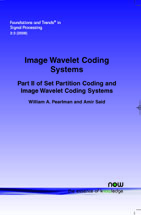Image Wavelet Coding Systems: Part II of Set Partition Coding and Image Wavelet Coding Systems
By William A. Pearlman, Department of Electrical, Computer and System Engineering, Rensselaer Polytechnic Institute, USA, pearlw@ecse.rpi.edu | Amir Said, Hewlett-Packard Laboratories, USA, Said@hpl.hp.com
Abstract
This monograph describes current-day wavelet transform image coding systems. As in the first part, steps of the algorithms are explained thoroughly and set apart. An image coding system consists of several stages: transformation, quantization, set partition or adaptive entropy coding or both, decoding including rate control, inverse transformation, de-quantization, and optional processing (see Figure 1.6). Wavelet transform systems can provide many desirable properties besides high efficiency, such as scalability in quality, scalability in resolution, and region-of-interest access to the coded bitstream. These properties are built into the JPEG2000 standard, so its coding will be fully described. Since JPEG2000 codes subblocks of subbands, other methods, such as SBHP (Subband Block Hierarchical Partitioning) [3] and EZBC (Embedded Zero Block Coder) [8], that code subbands or its subblocks independently are also described. The emphasis in this part is the use of the basic algorithms presented in the previous part in ways that achieve these desirable bitstream properties. In this vein, we describe a modification of the tree-based coding in SPIHT (Set Partitioning In Hierarchical Trees) [15], whose output bitstream can be decoded partially corresponding to a designated region of interest and is simultaneously quality and resolution scalable.
This monograph is extracted and adapted from the forthcoming textbook entitled Digital Signal Compression: Principles and Practice by William A. Pearlman and Amir Said, Cambridge University Press, 2009.
Image Wavelet Coding Systems
Set partition coding is a simple, popular, and effective method that has produced some of the best results in image and signal coding. Nevertheless, the literature has not adequately explained the principles of this method that make it so effective. This article, in tandem with Part I, which is available separately, remedies this situation and describe various image wavelet coding systems, most of which use set partition coding in some form. In Part II, various image wavelet coding systems are described from input to output. Featured are systems that incoporate set partition coding as primary or secondary methods of compression. A particular emphasis is the means to realize desirable compressed bitstream properties, such as progressive fidelity and progressive resolution encoding and decoding and direct selection of regions of interest for decoding. Also described are methods to allocate a given number of code bits to wavelet coefficients so as to achieve the least distortion. The particular systems described in this part include SBHP (Subband Block Hierarchical Partitioning), EZBC (Embedded Zero Block Coding), JPEG2000, and a version of SPIHT that enables simultaneously the bitstream properties mentioned above. Parts I and II together build to a tutorial that is written on a level suitable for students and practitioners of image and signal compression. A unique aspect is the setting apart in boxes of the detailed steps of the algorithms in addition to explanation of these steps and their underlying principles. Many figures and examples are sprinkled throughout to aid understanding
